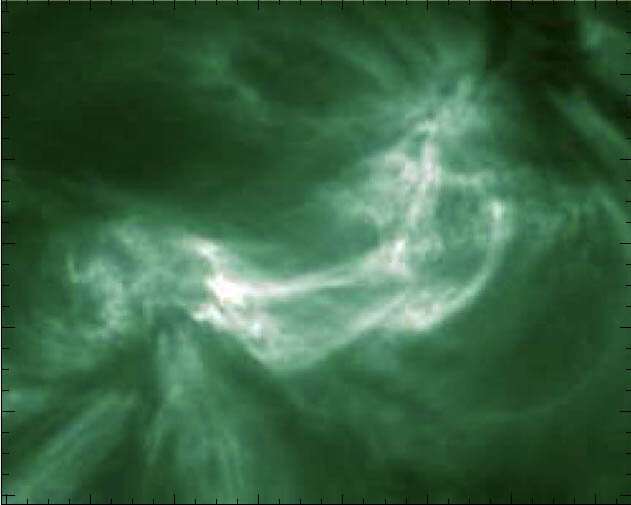Heating the solar corona

The hot outer layer of the sun, the corona, has a temperature of over a million degrees Kelvin, much more than the surface temperature of the Sun which is only about 5500 degrees Kelvin. Moreover, the corona is very active and ejects a wind of charged particles at a rate equivalent to about one-millionth of the moon's mass each year. Some of these particles bombard the Earth, producing auroral glows and occasionally disrupting global communications. There are two important, longstanding, and related questions about the corona that astronomers are working to answer: how is it heated to temperatures that are so much hotter than the surface? And how does the corona produce the wind?
The role of impulsive events is thought to be key to unraveling this problem. Flares are the most prominent such events, but it is believed that flaring also scales down to much smaller levels of activity—so-called nanoflares. The origins and properties of the energy release mechanisms in flares are often obscured by local heating effects, and instruments need to have good sensitivity, rapid response time, and some luck to retrieve useful data on flares amidst the complex seething cauldron of activity, while nanoflares are faint and elusive. Intermediate scale events are therefore thought to offer important ways to probe the energy release processes.
CfA astronomer Paola Testa is a member of a team of astronomers studying flares using IRIS (the Interface Region Imaging Spectrograph), an instrument on the Solar Dynamics Observatory, a NASA small explorer spacecraft that was launched in 2013 (the telescope for IRIS was provided by SAO). Recently, IRIS observed intermediate scale flaring events that were detected through brightenings at the footpoints of coronal loops and characterized by having high velocity, upward motions caused by impulsive heating. IRIS measured the ultraviolet line of highly ionized silicon to reveal highly variable activity over timescales of twenty to sixty seconds, implying the presence of magnetic loops of activity.
The clear correspondence between the brightening seen by IRIS and these coronal loops prompted the scientists to undertake a systematic study of the events. The scientists report that the localized brightenings found at the base of very hot coronal loops can indeed be treated as systems of interacting loops, and argue that the loop interactions determine the characteristic high temperatures and other behaviors that flag the production of intermediate-sized flares.
More information: Fabio Reale et al. Impulsive Coronal Heating from Large-scale Magnetic Rearrangements: From IRIS to SDO/AIA, The Astrophysical Journal (2019). DOI: 10.3847/1538-4357/ab304f
Journal information: Astrophysical Journal
Provided by Harvard-Smithsonian Center for Astrophysics


















